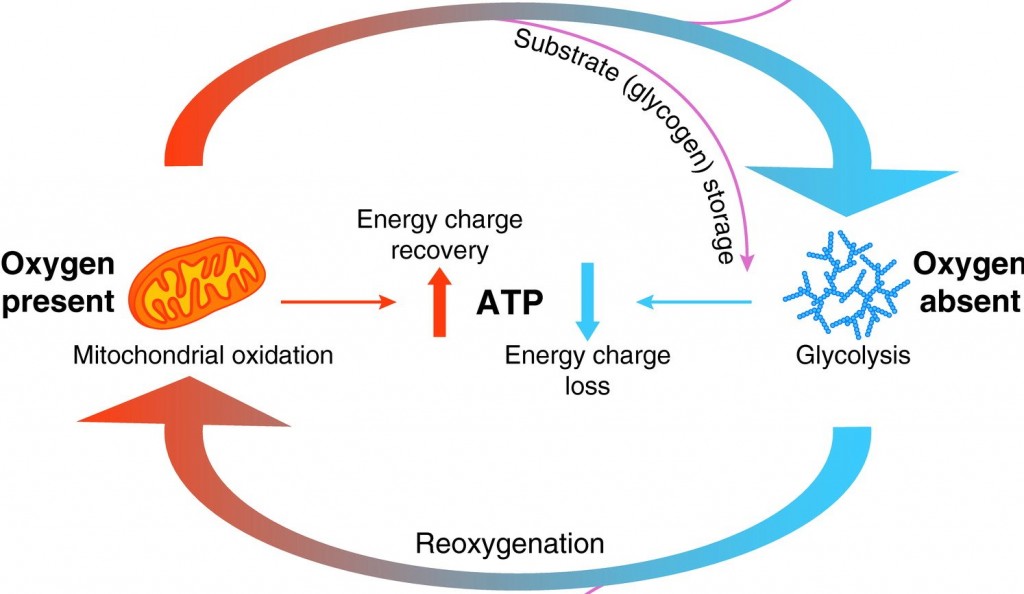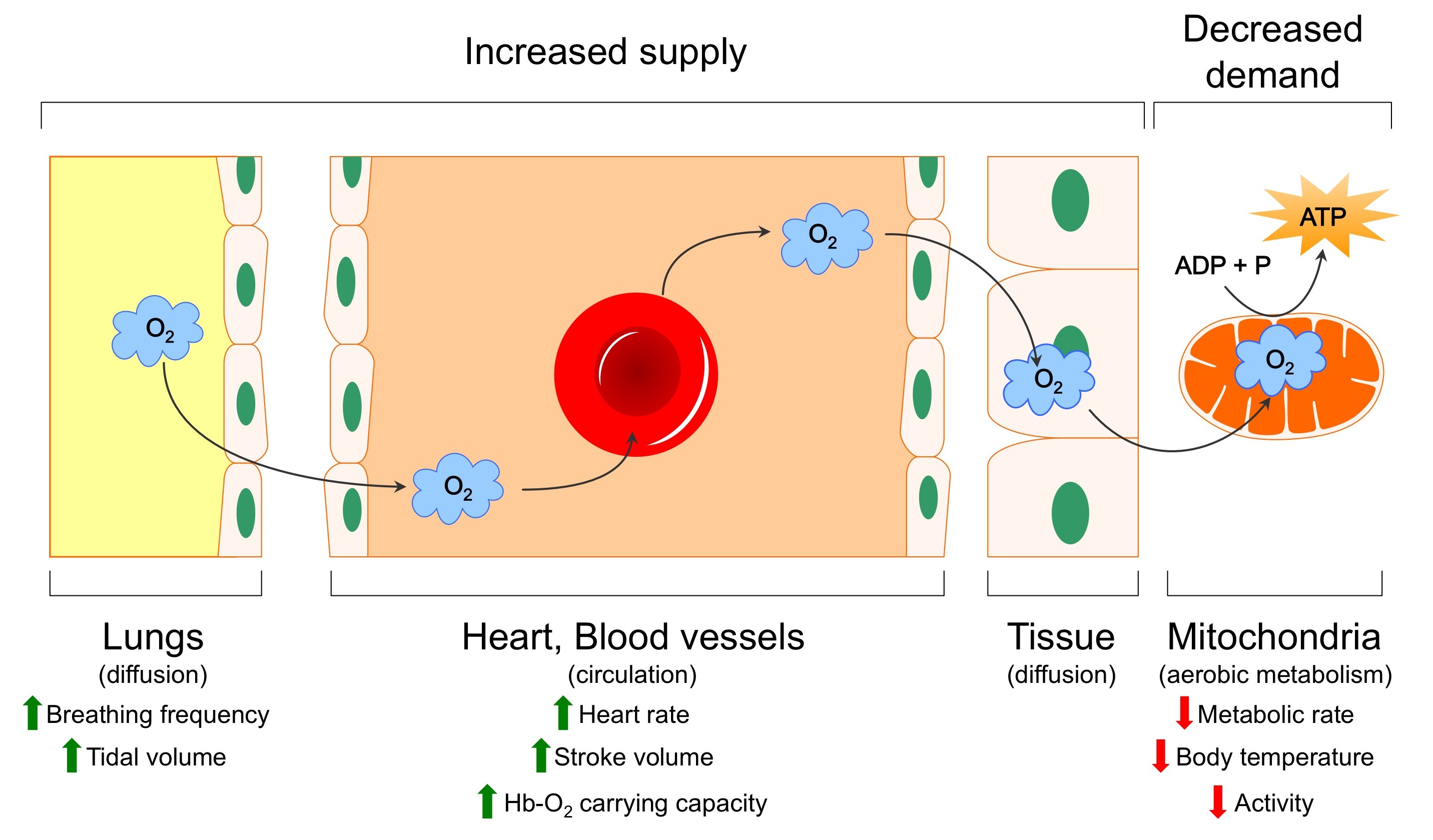The Hypoxic Challenge
Oxygen is critical for aerobic cellular respiration because oxygen serves as the terminal electron acceptor in the electron transport system (ETS). The ETS is a series of complexes, located on the inner mitochondrial membrane, that transfer electrons from electron donors to electron acceptors via redox reactions, and couples this electron transfer with the movement of protons (H+ ions) across the inner mitochondrial membrane. This creates an electrochemical proton gradient that drives the generation of chemical energy in the form of adenosine triphosphate (ATP). This is called oxidative phosphorylation.
During hypoxia,  oxidative phosphorylation is throttled as cellular oxygen availability decreases, resulting in a deficit of energy supply relative to an organism’s normal energetic demand in normoxia.
oxidative phosphorylation is throttled as cellular oxygen availability decreases, resulting in a deficit of energy supply relative to an organism’s normal energetic demand in normoxia.
Anaerobic energetic pathways (e.g. glycolysis) continue to produce ATP in the absence of oxygen. However, glycolysis is considerably less efficient than oxidative phosphorylation and the ratio of ATP produced from each molecule of glucose catabolized in the absence of oxygen is ~ 90% lower than in the presence of oxygen.
Importantly, hypoxic environments are common on Earth and many animals inhabit these regions and perform some or all of their daily activities or life cycle functions in varying or low oxygen. These animals may have to develop, forage, reproduce, and/or exercise in hypoxia, and this challenge has driven the evolution of a variety of adaptations that mitigate environmental hypoxia and permit hypoxia-tolerant species to live and thrive in these niches.
How do vertebrates respond to hypoxia?
Behaviour
The simplest solution to hypoxia is to leave the hypoxic environment.  Fleeing hypoxia is a common strategy among hypoxia-intolerant species. When hypoxia cannot be avoided, animals may seek colder environments or enter into torpor to take advantage of thermal- and activity-related metabolic savings, respectively.
Fleeing hypoxia is a common strategy among hypoxia-intolerant species. When hypoxia cannot be avoided, animals may seek colder environments or enter into torpor to take advantage of thermal- and activity-related metabolic savings, respectively.
In nature, naked mole-rats presumably experience unpredictable and intermittent periods of hypoxia in a relatively thermostable environment and therefore cannot employ strategies such as behavioural avoidance of hypoxia or torpor. Conversely, naked mole-rat colonies raised in research laboratories have, for the most part, been kept in room air and often at room temperature. We’re interested in understanding to what degree naked mole-rat behaviour is affected by hypoxic exposure, and how life history (previous exposures to hypoxia) effects their behaviour.
Increasing oxygen supply
The key to tolerating hypoxia is achieving a balance between energy supply and energy demand. Cellular energy production is drastically curtailed when oxygen is limited, thus, organisms that remain active in hypoxic environments often employ some combination of physiological adaptations across the oxygen transport cascade that serve to increase the rate at which the available environmental oxygen is delivered to the tissues. For example, changes in ventilation or heart rate, or adaptations in capillary-tissue diffusion distances and blood-oxygen carrying capacity can all improve the extraction of oxygen from hypoxic air and help to ameliorate the physiological impact of short-term or intermittent hypoxia.
Decreasing energy demand
Alternatively, metabolic rate depression reduces cellular energy demand and can mitigate the deleterious effects of acute or prolonged hypoxia. Metabolic rate depression is particularly critical for protecting the function of brain and heart, which are the most sensitive organs to hypoxic damage. 
What do we do?
We take a comparative approach to the study of hypoxia-tolerance. We study naked mole-rats (and other African mole-rats), freshwater western painted and red-eared slider turtles, and goldfish, which are among the most hypoxia-tolerant mammal, reptiles, and fish, respectively, in the world.
We’re interested in understanding the beneficial adaptations that have naturally arisen to protect these champions of hypoxia-tolerance against acute or prolonged low oxygen stress, from behaviour, to physiology, to molecular mechanism.
We’re particularly interested in the neural components of this protection, including the control of physiological responses to hypoxia, as well as cellular and synaptic mechanisms that decrease metabolic rate in the brains of hypoxia-tolerant species.
Here’s a summary of some of the tissues and areas of adaptation that we study in naked mole-rats:
Other Pamenter Lab research interests: Control of Breathing, Mitochondrial Energetics, Neurobiology.